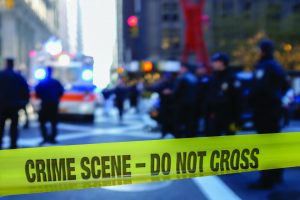Sadly, the United States bore witness to the loss of 25 innocent lives in less than two weeks as a result of active shooter incidents in the fall of this year.
n October 27, 2018—Pittsburgh, Pennsylvania: Eleven people killed in worship at the Tree of Life Synagogue
n November 3, 2018—Tallahassee, Florida: Two people killed at a yoga studio
n November 7, 2018—Thousand Oaks, California: Twelve people killed during College Night at a local bar
The Thousand Oaks victims included a veteran sergeant of the Ventura County, California, Sheriff’s Department, as well as a man who survived the Mandalay Bay shooting in Las Vegas just over a year ago. As you know, we have born witness to an evolving cache of weapons of choice in critical incidents—these tragic incidents are not just perpetrated by active shooters but also by attackers using knives and vehicles as weapons, among other methods.
As these tragic and senseless acts mount, I often find myself speechless when the news of another critical incident reaches me. Active shooters, bombings, vehicles repurposed as weapons of mass destruction… Sometimes these acts have links to terrorism, while others are steeped in misogyny, anti-Semitism, or racism. Still others appear to be entirely random.
As police leaders across the globe, we know that our entire law enforcement community is affected by each and every critical incident that occurs in our communities. Some wounds to our officers are visible, such as injuries or deaths in the line of duty. Others are less so, such as the post-traumatic stress symptoms that can be caused by witnessing horrible crimes against humanity. It’s important that we, as leaders, provide proper support to officers who are involved in these situations.
Law enforcement bears unique responsibilities in these types of incidents. We are tasked with the duality of neutralizing the threat and providing assistance to victims. While these tragedies occur with frightening frequency, we, as law enforcement leaders, do have the power to help mitigate these horrific events by being involved in our communities and building relationships where potential threats can be recognized, communicated, and thwarted. The threats are constantly evolving, and our tactics must evolve as well. We must continue to train, support, and give our officers the tools to respond to and survive these types of critical incidents.
Each critical incident will have its own components and will require a specific response. In recent years, the IACP has maintained a consistent focus on assisting agencies and police leaders in being as prepared as possible should a critical incident occur in their jurisdictions. In looking to how we can help, the IACP has a developed a plethora of resources that can be utilized by agencies to bolster policies and training. The resources mentioned here are only a sample of the projects and programs we are working on.
In cases that involve a deliberate selection of victims based on actual or perceived demographic characteristics, the IACP Law Enforcement Policy Center provides guidance on how to respond to hate crimes in the form of an Investigation of Hate Crimes Model Policy and Concepts & Issues Paper. For incidents with dual components, such as the Pittsburgh synagogue shooting where an active shooting was perpetrated as a hate crime, agencies may want to consider utilizing the hate crimes–related documents as well as the recently updated Active Shooter Model Policy and Paper. Given how common such events have become, both sets of documents are available to the public for free on the IACP website.
We know that school violence and shootings are occurring at an alarming rate. To meet law enforcement’s needs in this area, the IACP has worked on a project in concert with the U.S. Bureau of Justice Assistance; the Guide for Preventing and Responding to School Violence provides agencies with a comprehensive toolkit for how to prevent, assess, and respond to violence in schools. Whether this resource helps prevents a school-based attack or simply improves communication between police and school officials, our communities will become stronger.
We will continue to provide updated resources as they relate to school violence. In conjunction with the U.S. Department of Justice and a core group of law enforcement stakeholders as part of the National School Safety Consortium, we are focusing on comprehensive school safety efforts globally, with a focus on multidisciplinary coordination with school administrators, mental health providers, the community, parents, federal agencies, and various advocacy groups and associations that involved in school safety efforts.
Finally, the IACP Law Enforcement Policy Center offers a Critical Incident Stress Management Model Policy and Paper, which provide a framework and supporting information for debriefing employees and recognizing when an employee might need support. The IACP Center for Officer Safety and Wellness offers additional helpful resources to maintain the strength and health of agency personnel. Only when our officers are safe, can they protect the communities they serve.
If we remain vigilant, through proactive efforts, the number of casualties from critical incidents can effectively be reduced and our communities will be safer.
Let us never forget those we have lost.
With so many holidays worldwide taking place this month, I wish everyone a happy and safe holiday season.d
Please cite as
Paul M. Cell, “Improving Community Safety Through Vigilance and Planning,” President’s Message, Police Chief 85, no. 12 (2018): 6–7.


